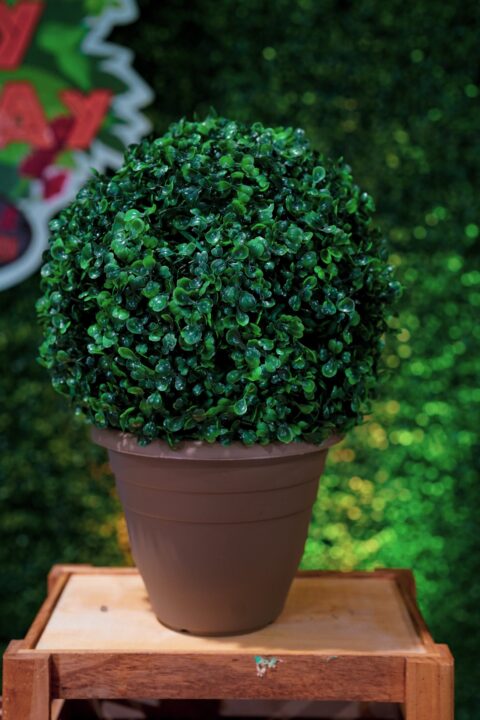Are you in search of the perfect shrub for your garden? One that is capable of scaring away deer and rabbits. Then, one of the plants you should consider is the green mound boxwood.
Green mound boxwood is an evergreen, hardy, woody shrub that is good for the hedges of your garden. It is very easy to manage and cultivate. Green mound boxwood was introduced by Sheridan Nurseries in 1976. It is a hybrid because of its mixed parentage. Green mound boxwood is so hardy it can withstand extreme weather like frost, which is 30° below, i.e., 30°.
Origin
Green mound boxwood is originally from Europe and Asia. It is one of the most planted garden shrubs, dating back to 4000 BC. In 1976, Sheridan Nurseries reintroduced it into the garden world in Ontario, Canada.
Common Name
Green mound boxwood is called buxus in Latin and boxwood or box tree in English. Boxwood got its name from the previous use of its wood to make boxes and its young plants’ quadrangular (square box cross-section) stems. Green mound boxwood is from the botanical family of Buxacaea and an English family of Boxwood.
Features of Green Mound Boxwood
1. Flower Colour and Fragrance
The green mound boxwood flower is inconspicuous and fairly fragrant. It appears as little greenish-cream flowers in terminal and axillary clusters bloom in April and May.
2. Foliage
The foliage of green mound boxwood is emerald green and retains its rich green color even in winter.
3. Height and Spread
Green mound boxwood grows as high as 2 – 3 feet tall and as wide over the first 10, and eventually, the green mound boxwood matures to 4 – 5 feet tall with smooth lined margins.
Factors to Consider When Growing Green Mond Boxwood
1. Where to Grow
Green mound boxwood is a hybrid plant that is not very selective or can only be grown on one soil type. The following subheadings will discuss the soil types in which green mound boxwood can be grown, the kind of drainage soil system it requires, and the pH of the soil that promotes its healthy growth.
2. Soil Type
Green mound boxwood can be grown with different types of soils, including chalky, clay, loamy and sandy soils.
3. Soil Drainage
Green mound boxwood is best grown in evenly moist and well-drained soil. This enables it to grow properly without one part of the plant withering while the other part is blossoming. A properly drained soil helps prevent premature decay of the plant.
4. Soil pH
Green mound boxwood requires soils with slightly acidic to slightly alkaline pH. Which means it’s either acidic or alkaline but not too acidic or too alkaline.
5. Weather Conditions
Green mound boxwood prefers sun shading situations because full exposure to full-day sun can cause extreme vaporization, especially in the winter. This causes extreme dehydration and bronzing of the leaves, where the rich green foliage becomes brownish-yellow and eventually falls off.
Therefore, light exposure should ideally be 6 hours of full sun daily, which is direct sunlight, and 4 to 6 hours of shaded or partial sunlight daily.
In the cases of winter winds, green mound boxwood should be shielded or moved into a shed if in an open area. This is because winter winds remove moisture from plants at a very fast rate, which results in dehydration and bronzing.
6. Cultivation
Green mound boxwood is cultivated based on the purpose you want it to serve but primarily, green mound boxwood should not be left in full sun to avoid scorching it. For Topiary Gardening or hedging, young green mound boxwood plants should be planted below the mark of the soil nursery to promote growth from the base.
Uses Of Green Mound Boxwood
-

adrien olichon, pexels, 14975230.jpg
Green mound boxwood has various uses. It is popularly used for Garden edging, hedging or screens, and topiary gardening to prevent droughts, rabbits and deer invasion.
USDA Hardiness Zones
Hardiness zones are geographical areas’ average annual minimum temperature necessary for plants’ survival. The USDA hardiness zones that encourage the survival of green mound boxwood are Zone 5 (Northern Illinois), Zone 6 (City of Chicago), Zone 7 and Zone 8. You can learn more about USDA Hardiness Zones here.
Subset Zones
There are subset zones under USDA zones; they include 3B, 4,5,6,15, 16, 17.
Seasons of Interest
Green mound boxwood is a winter-loving plant that grows best in early, mid, and late winter.
Shape
Green mound boxwood is spherical, compact, rounded and broad with narrow- elliptic leaves.
Toxicity
Green mound boxwood can cause skin irritation when in contact with bare skin and if ingested, it can cause stomach upsets. This means one has to be adequately covered before handling green mound boxwood, and on no account should it be ingested.
How to Care for Green Mound Boxwood
Green mound boxwood benefits from pruning and propagation. Pruning should be done in early spring but not too early because pruning too early promotes new growth that is tender enough to be killed by late spring frost.
Green mound boxwood should not be planted around other plants because it has shallow roots. Pruning off thin plants and dead branches helps promote air circulation. Propagation methods that can be used for green mound boxwood include semi-hardwood cuttings and softwood cuttings.
Pests and Diseases
Like every other plant, green mound boxwood can be infested by pests. The main three pests that infest green mound boxwood are Boxwood psyllids, leaf miners and Boxwood mites. In the deep south, nematodes can be a problem. Road salts and winter burn can help chase or prevent a pest invasion.
Other pests of green mound boxwood include box sucker, mussel scale, and red spider mite. Diseases that green mound boxwood suffers are box blights and leaf spots.
Monthly Care Advice for Green Mound Boxwood
Green mound boxwood does not need much care, but specific care should be given, including annual pruning. For monthly Care, the following should be taken note of;
- Only unsightly shoots should be pruned out.
- Softwood cuttings should be done.
- Semi-hardwood cuttings should be done in late summer.
- Green mound boxwood should be planted in fertile humus-rich soils that are properly drained.
- Green mound boxwood in topiary shapes should be pruned to maintain the shapes.
- Green mound boxwood should be planted in either partial shade (autumn) or full shade ( spring).
Growth Rate of Green Mound Boxwood
Green mound boxwood is a slow-growing shrub. It can take 10 to 20 years to mature fully.
Cultivars Of Green Mound Boxwood
Green mound boxwood has several other Cultivars or varieties. Boxwoods are hybrids due to their complex parentage. These cultivars include:
- Chicagoland Green® boxwood (buxus ‘glencoe’); which is famous for being introduced by Chicagoland Grow®.
- Green Gem boxwood (buxus ‘ Green Gem’); it is commonly known as the slowest boxwood cultivar.
- Green Mountain boxwood (buxus ‘Green Mountain’); famously known for its 4-5 feet height and 3-4 feet width. It has a pyramidal form, unlike other cultivars.
- Green Velvet boxwood (buxus ‘ Green Velvet’); it is a globed-shape cultivar.
- Northern Charm™ boxwood (buxus ‘Wilson’); it is also a Chicagoland Grow™ introduction but it is hardy to Zone 4.
Conclusion
Green mound boxwood is a very good hybrid boxwood cultivar to plant. It is easy to cultivate and doesn’t require excessive pruning.





